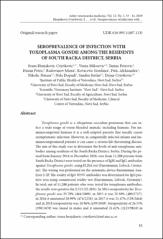| dc.contributor.author | Hrnjaković Cvjetković, Ivana | |
| dc.contributor.author | Milošević, Vesna | |
| dc.contributor.author | Petrović, Tamaš | |
| dc.contributor.author | Petrić, Dušan | |
| dc.contributor.author | Radovanov, Jelena | |
| dc.contributor.author | Kovačević, Gordana | |
| dc.contributor.author | Patić, Aleksandra | |
| dc.contributor.author | Nikolić, Nataša | |
| dc.contributor.author | Dopuđ, Nela | |
| dc.contributor.author | Stefan, Sandra | |
| dc.contributor.author | Cvjetković, Dejan | |
| dc.date.accessioned | 2019-10-24T18:37:39Z | |
| dc.date.available | 2019-10-24T18:37:39Z | |
| dc.date.issued | 2019 | |
| dc.identifier.issn | 1820-9955 | |
| dc.identifier.uri | https://repo.niv.ns.ac.rs/xmlui/handle/123456789/56 | |
| dc.description.abstract | Toxoplasma gondii is a ubiquitous coccidian protozoan that can infect a wide range of warm-blooded animals, including humans. For immunocompetent humans it is a well-adapted parasite that usually causes asymptomatic infection. However, in congenitally infected infants and immunocompromised patients it can cause a serious life threatening disease. The aim of this study was to determine the levels of anti-toxoplasma antibodies among residents of the South Backa District, Serbia. During the period from January 2014 to December 2018, sera from 11,288 persons from South Backa District were tested on the presence of IgM and IgG antibodies against Toxoplasma gondii, using ELISA test (Euroimmun, Lübeck, Germany). The testing was performed on the automatic device Euroimmun Analyzer I-2P. Th e avidity of IgG WNV antibodies was determined for IgG positive sera using commercial avidity test (Euroimmun, Lübeck, Germany). In total, out of 11,288 patients who were tested for toxoplasma antibodies, the results were positive for 2,513 (22.26%). In 2014 seropositivity for Toxoplasma gondii was 25.78% (464/1800), in 2015 it was 23.30% (400/1717), in 2016 it amounted 20.99% (474/2258), in 2017 it was 21.47% (529/2464) and in 2018 seropositivity was 20.96% (639/3049). Seropositivity of 26.53% (390/1470) was found in males and it amounted 21.62% (2123/9818) in females. Possible recent infection within the last 12 months was found in 1.70% (192/11288) patients. Possible acute infection or false - positive IgM result was detected in 1.31% (148/11288) patients. Past infection was found in 2173/11288 (19.25%) patients. Equivocal results were found in 1.48% of samples (167/11288). The lowest frequency of anti-toxoplasma antibodies was detected in pre-school children 13.07% (97/742) and the highest in persons older than 65 years 60.18% (65/108). Comparing the results of the research done from 2014 to 2018 with the data from 1989, a significant decline of seroprevalence in general population and women of generative age was found. | en_US |
| dc.description.sponsorship | This work is conducted within the projects TR31084 and III43007 funded by the Serbian Ministry of Education, Science and Technological development | en_US |
| dc.language.iso | en | en_US |
| dc.publisher | Naučni institut za veterinarstvo "Novi Sad" | en_US |
| dc.source | Arhiv veterinarske medicine / Archives of veterinary medicine | sr |
| dc.subject | Toxoplasma gondii | en_US |
| dc.subject | IgG ELISA | en_US |
| dc.subject | IgM ELISA | en_US |
| dc.title | Seroprevalence of infection with Toxoplasma gondii among the residents of South Backa District, Serbia | en_US |
| dc.title.alternative | Seroprevalenca infekcije protoozom Toxoplazma gondii u pripadnika populacije Južno Bačkog okruga | en_US |
| dc.type | Article | en_US |
| dc.identifier.doi | 10.46784/e-avm.v12i1.41 | |

